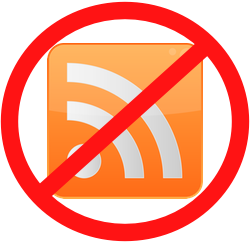The Surprising Marketing Benefit Now that Google Reader is Going Away
 Last week, Google announced it’s shutting down the much-loved Google Reader. As often occurs in these cases, the Internet—including me—lost its collective mind.
Last week, Google announced it’s shutting down the much-loved Google Reader. As often occurs in these cases, the Internet—including me—lost its collective mind.
Why?
Well, without going into an overly detailed explanation of what RSS is, (you can check out Common Craft’s great introduction if you need it), RSS often brings “significant” traffic volumes to many blogs and other websites. And it’s an enormously helpful tool for knowledge management.
Except, you’ll notice I put “significant” in quotes up above.
Again, why?
Well, near as I can tell, Reader actually isn’t bringing me all that much traffic. Nor much to other sites I monitor regularly. And MG Siegler at TechCrunch notes that Reader is the #4 or #5 referrer to the site, accounting “…for a little over three percent of all visits.”
Um… what? 3%? That’s “significant”?
Now, as Siegler rightly notes, the folks using Reader may in fact represent a particularly influential category of users, far more likely to tweet and share and like and link. His “honeybee” metaphor underscores that the loss of this traffic may cause declines far out of proportion to the actual number of visits or visitors.
But, if your site’s traffic depends so heavily on only 3% of your total audience, I suspect you’ve got a much bigger problem.
I often talk about the value of developing an overall web presence, one that leverages your website, email marketing, and social channels to connect and communicate with your customers. In fact, I just dedicated a recent episode of Thinks Out Loud (our podcast), to building your web presence in detail and during that episode I noted the following three types of media:
- Owned media
- Paid media
- Earned media
Owned media, of course, represents channels you actually own, such as your website or your email list. Paid media covers those channels you trade one thing for (usually money) in exchange for exposure. It includes such items as print and broadcast media, search engine marketing, banner ads, and similar efforts. And earned represents the likes and links and shares and tweets we all covet and work to build through our content marketing efforts.
Now, it’s common to think of RSS subscribers (and Facebook fans, Twitter followers, Google+ friends and the like), as “owned.” But they’re not. They’re “borrowed” or “rented” or “leased.” If any RSS reader decides to shut down (as Google’s doing with Reader), those subscribers, theoretically, go away. Forever. (The same is true for the folks following you on Facebook, Twitter, and Google+, which is why I often argue against using these tools as the primary component of your web presence).
Your job in Internet marketing isn’t just to build your audience, but to build an audience you can keep over the long haul. Google shutting down Reader is a bummer, but it’s also an opportunity: to convert “borrowed” traffic to “owned.”
Over the next few months between now and July 1 (Google’s official shutdown date for Reader), create a few posts encouraging your Reader subscribers to subscribe to your email newsletter and to bookmark your site.
Additionally, now might be a good time to de-emphasize the importance of RSS subscriptions on your site and instead highlight your email newsletter (I’ve been doing the same for the last few months and will ramp up those efforts in the coming weeks).
In my experience, not only do these “owned” channels grant you more control, but visitors delivered via these media spend more time on site, view more pages, and convert at higher rates.
So, yes, Google Reader shutting down kind of sucks. Personally, I’m going to miss the value it provided me. And, yes, it’s possible that the potential loss of traffic from Reader could have downstream, “honeybee” implications. But you can take action to mitigate these risks by moving your customers from “borrowed” media channels to “owned” and by ensuring your web presence actively works to grow your email list. In the long run, a successful web presence cannot rely on channels it doesn’t control. Take this opportunity to improve the value of those “owned” channels to your business—and to your customers.
Interested in more? Sign up for our free newsletter and get more information on how to build your social, local, mobile marketing strategy. And, if you’ve got a minute, you might enjoy some past coverage on building a successful web presence:

This Post Has 0 Comments